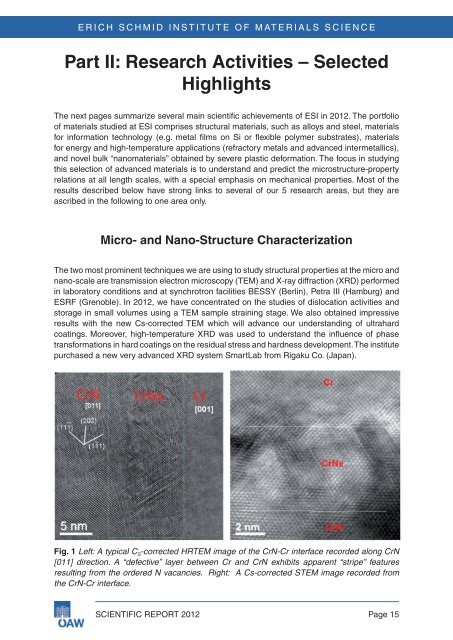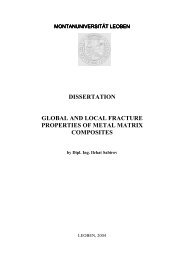Scientific Advisory Board - Erich Schmid Institute
Scientific Advisory Board - Erich Schmid Institute
Scientific Advisory Board - Erich Schmid Institute
You also want an ePaper? Increase the reach of your titles
YUMPU automatically turns print PDFs into web optimized ePapers that Google loves.
ERICH SCHMID INSTITUTE OF MATERIALS SCIENCE<br />
Part II: Research Activities – Selected<br />
Highlights<br />
the next pages summarize several main scientific achievements of eSi in 2012. the portfolio<br />
of materials studied at eSi comprises structural materials, such as alloys and steel, materials<br />
for information technology (e.g. metal films on Si or flexible polymer substrates), materials<br />
for energy and high-temperature applications (refractory metals and advanced intermetallics),<br />
and novel bulk “nanomaterials” obtained by severe plastic deformation. the focus in studying<br />
this selection of advanced materials is to understand and predict the micro structure-property<br />
relations at all length scales, with a special emphasis on mechanical properties. most of the<br />
results described below have strong links to several of our 5 research areas, but they are<br />
ascribed in the following to one area only.<br />
Micro- and Nano-Structure Characterization<br />
the two most prominent techniques we are using to study structural properties at the micro and<br />
nano-scale are transmission electron microscopy (tem) and X-ray diffraction (XRd) performed<br />
in laboratory conditions and at synchrotron facilities BeSSY (Berlin), petra iii (Hamburg) and<br />
eSRf (grenoble). in 2012, we have concentrated on the studies of dislocation activities and<br />
storage in small volumes using a tem sample straining stage. We also obtained impressive<br />
results with the new cs-corrected tem which will advance our understanding of ultrahard<br />
coatings. moreover, high-temperature XRd was used to understand the influence of phase<br />
transformations in hard coatings on the residual stress and hardness development. the institute<br />
purchased a new very advanced XRd system SmartLab from Rigaku co. (Japan).<br />
Fig . 1 Left: A typical C S-corrected HRTEM image of the CrN-Cr interface recorded along CrN<br />
[011] direction. A “defective” layer between Cr and CrN exhibits apparent “stripe” features<br />
resulting from the ordered N vacancies. Right: A Cs-corrected STEM image recorded from<br />
the CrN-Cr interface.<br />
<strong>Scientific</strong> RepoRt 2012 page 15

















